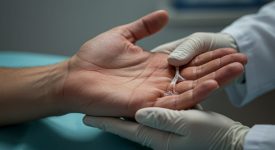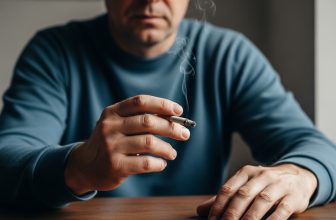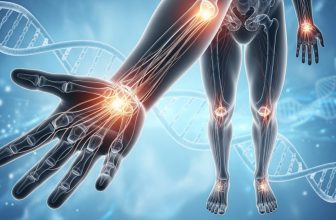
Dupuytren’s Recurrence: Why It Happens and How to Prevent It
Dupuytren’s Recurrence: Why It Happens and How to Prevent It
Introduction – Dupuytren’s recurrence
For many patients, the greatest disappointment after treatment for Dupuytren’s Contracture is seeing the cords return. Recurrence can be discouraging, but it doesn’t mean treatment failed. Instead, it reflects the underlying biology of the disease. Dupuytren’s is a chronic, progressive condition influenced by genetics, inflammation, and connective tissue behavior. Understanding why it happens—and what you can do about it—allows patients to take an active role in long-term management.
Why It Returns
Dupuytren’s Contracture begins when overactive fibroblasts in the palm’s fascia produce too much collagen, forming thick cords that pull the fingers inward. Even when these cords are removed surgically or dissolved with injections, some fibroblasts remain active beneath the surface. Over time, these residual cells can restart the collagen-building process.
Inflammation, oxidative stress, or metabolic imbalances can fuel this reactivation. Studies show that recurrence rates range widely—from about 20% to 60%—depending on the procedure used and the disease stage. Needle aponeurotomy (NA), for example, offers a faster recovery and minimal scarring but tends to have slightly higher recurrence compared to open fasciectomy, which removes more tissue but requires longer healing.
The key takeaway: recurrence isn’t random. It reflects a biological cycle that can be influenced—but not fully stopped—by how we manage inflammation and tissue health after treatment.
Risk Factors for Recurrence
Certain factors make recurrence more likely, especially when the disease appears early or runs in families. Known risk factors include:
- Early-onset disease (before age 50).
- Family history of Dupuytren’s or related conditions such as Ledderhose disease (plantar fibromatosis).
- Smoking, diabetes, and chronic alcohol use.
- Persistent inflammation, insulin resistance, or metabolic syndrome.
These factors share one common thread: they all contribute to higher oxidative stress and collagen imbalance in connective tissue. Addressing these root causes is essential for long-term disease control. (See also: Ledderhose Disease and Dupuytren’s and Nutrition and Diet in Dupuytren’s.)
Inflammation and Scar Tissue
Inflammation is both friend and foe in Dupuytren’s disease. On one hand, it’s part of normal healing after surgery or collagenase injections. On the other, excessive inflammation activates myofibroblasts—the very cells that cause tissue tightening. When repair processes go into overdrive, the fascia thickens again, leading to recurrent contractures.
This is why careful post-treatment care is vital. Gentle stretching, scar massage, and hand therapy help guide the healing tissue to remain flexible. Without this support, the fascia can stiffen and pull the fingers back into a bent position. Research from the Mayo Clinic and the National Institutes of Health (NIH) has linked oxidative stress and mitochondrial dysfunction to faster recurrence, suggesting that the health of the body’s energy-producing cells plays a significant role. (See also: Cellular Energy and Dupuytren’s Contracture.)
Treatment Options After Recurrence
If Dupuytren’s returns, several management options can help restore function and slow further progression. The right approach depends on how severe the contracture is:
- Repeat Needle Aponeurotomy or Collagenase Injections: For mild or moderate recurrences, these less invasive procedures can be repeated to release new cords with minimal downtime.
- Surgical Revision (Fasciectomy): In advanced cases with thick scar tissue, surgical excision may be needed to remove diseased fascia. Although recovery is longer, recurrence rates tend to be lower.
- Radiation Therapy: Low-dose radiotherapy can be used for early-stage nodules to reduce fibroblast activity and delay cord formation.
- Occupational Therapy and Splinting: Customized splints and guided exercises help maintain finger extension and flexibility after any procedure.
- Lifestyle Interventions: An anti-inflammatory diet, glucose control, and regular exercise help reduce metabolic stress and keep connective tissues healthier overall.
What the Science Says
Scientific studies continue to highlight the importance of addressing Dupuytren’s as a systemic condition, not just a local hand problem. A 2019 study published in the Journal of Hand Surgery found that patients who actively managed inflammation, blood sugar, and oxidative stress experienced slower and less severe recurrence. The authors emphasized “whole-person management,” meaning that long-term success comes from treating the patient’s overall health, not just removing the cords.
Nutritional approaches are also gaining attention. Diets rich in antioxidants—such as those found in leafy greens, berries, and omega-3 fats—may help reduce fibroblast activation. Meanwhile, avoiding smoking, processed sugars, and excess alcohol can lower systemic inflammation that drives fibrosis.
Takeaway for Patients
The return of Dupuytren’s cords can feel discouraging, but it’s not a personal failure or a sign of poor surgery. It’s part of a biological process that can be managed with awareness and proactive care. Prevention requires ongoing attention—balancing collagen production, calming inflammation, and maintaining healthy connective tissue through lifestyle choices.
Regular follow-up with a hand specialist or therapist is crucial, especially if you notice early signs of stiffness or new nodules. Early intervention can stop small changes before they develop into full contractures again.
Key Takeaways
- Recurrence reflects the disease’s biology, not surgical failure.
- Inflammation, genetics, and lifestyle factors reactivate fibrosis.
- Consistent therapy, stretching, and proper nutrition reduce risk.
- Early detection and long-term management prevent secondary surgery.
By viewing Dupuytren’s as a lifelong condition rather than a one-time problem, patients can build a sustainable strategy to preserve hand function and minimize recurrence for years to come.
If you’re living with diabetes, learn how to protect your hands. Visit https://www.dupuytrensolutions.com and join our support network at https://www.facebook.com/groups/dupuytrensolutionsandhealth.






